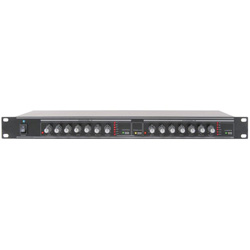
All Systems Under Control
Signal overload problems may occur when cascading multiple audio signal processors.
Take for example a parametric equalizer with a single band boosted by 10 dB to flatten a room.
If a loud note in this same frequency range is present, the overload light on the equalizer illuminates.
By then it is too late, the signal is clipped. Additionally, overloading could be overlooked if the overload indicators are obscured by security covers or a closed rack.
This problem is corrected by adding a 4-channel limiter with all four channels slaved together.
The first channel is the primary input limiter and up to 3 points are simultaneously monitored by the limiter’s other 3 channels.
The threat of overload automatically activates the limiter rather than lighting an LED, thus preventing overload altogether. Simply add a wye (Y) connector in the audio path anywhere you need protection and connect it to one of the 3 other inputs.
When any single processor nears an unwanted level, the first channel limits the gain at the input of the whole system, preventing overload.
Reign Over Your Volume
A benefit of limiters is their automatic gain control ability. No one needs to be present to watch and change the levels of a system once you properly set the thresholds.
A limiter prevents the need to gain ride a system. In this sense, the limiter acts as a compressor. Increase the volume so that the quiet parts are loud enough to be heard and the limiter automatically prevents the loud passages from clipping the amplifiers or overpowering the speakers.
Professional audio systems are often operated by untrained people. Take a music/paging system in a restaurant for instance.
The owner of a restaurant wants specific levels of music in certain dining rooms so his customers or neighboring businesses will not be annoyed.
Placing a limiter in the audio chain will prevent everyday users from turning the volume up too loud. The limiter’s circuit tends the shop.
Another application involves hearing. We sometimes take our hearing for granted. Hearing is non-linear and constantly changing. When the sounds our ears pick up get loud (sensitivity to loudness varies with different people), some automatic systems come into play.
Some of these changes are aural (involuntary muscular responses in the ear) and some are neural (the way the brain responds to impulses from the ear). The mechanism between the ear and brain begins to shut down in an attempt to protect itself.
This action manifests itself by dulling your hearing senses. The natural response to this is to boost the volume or EQ controls to compensate for the perceived drop in level.
Extended exposure to high sound levels can result in permanent hearing damage. Limiters help control these levels. When using a limiter for this purpose we recommend security covers to make the settings tamper proof.
Summary
Put limiters in the signal path—anywhere there is a place where signals can’t be monitored by someone or where there might be too much signal.
At the output of the signal source, at the input of an equalizer, at the input of a mixer, at the input of a power amplifier or at the input to an active crossover.
You can be very creative with limiters to achieve your particular goal. Especially if your limiter has an auto-slave option.
